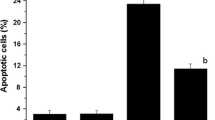Abstract
The protective effects of captopril (CAP) against toxicity induced by cyclophosphamide (CP) in mice were investigated using the micronucleus assay for anticlastogenic activity in mouse bone marrow cells and liver glutathione (GSH) content. A single intraperitoneal (i.p.) injection of CAP at 50, 100, and 200 mg/kg 1 h prior to cyclophosphamide (50 mg/kg) reduced the frequency of micronucleated polychromatic erythrocytes (MnPCEs). All three doses of CAP significantly reduced the frequency of MnPCEs in mouse bone marrow compared to the group treated with CP alone (P<0.0001–0.01). CP significantly depleted the GSH content in liver but the application of CAP at a dose of 100 mg/kg 1 h before CP treatment repleted the GSH content. CAP exhibited concentration-dependent antioxidant activity, scavenging >96% of the 1,1-diphenyl-2-picryl hydrazyl free radicals when used at a concentration of 0.2 mM. It appears that CAP, due to its antioxidant activity and by increasing GSH levels, can modulate the reduced cellular thiol content induced by CP and reduce the genotoxicity of CP in bone marrow cells.


Similar content being viewed by others
References
Abd El-Aziz MA, Amer AL, El-Missiry MA (2001) Potential protective role of angiotensin-converting enzyme inhibitors captopril and enalapril against adriamycin-induced acute cardiac and hepatic toxicity in rats. Appl Toxicol 21:469–473
Anderson ME (1998) Glutathione: an overview of biosynthesis and modulation. Chem Biol Interact 111–112:1–14
Bartosz M, Kedziora J, Bartosz G (1997) Antioxidant and prooxidant properties of captopril and enalapril. Free Radic Biol Med 23:729–735
Blasiak J, Gloc E, Wozniak K, Mlynarski W, Stolarska M (2002) Genotoxicity of idarubicin and its modulation by vitamins C and E and amifostine. Chem Biol Interact 140:1–18
Brookes P (1990) The early history of the biological alkylating agents. Mutat Res 233:3–14
Cavanagh EMD, Inserra F, Ferder L (2002) Enalaperil and captopril enhance glutathione-dependent antioxidant defenses in mouse tissues. Am J Physiol Regul Integr Comp Physiol 278:572–577
Donnerstag B, Ohlenschlager B, Cinatle J (1996) Reduced glutathione and S-acetylglutathione as selective apoptosis-inducing agents in cancer therapy. Cancer Lett 110:63–70
Fraiser LH, Kanekal S, Kehrer JP (1991) Cyclophosphamide toxicity. Drugs 42:781–795
Griggs JJ (1998) Reducing the toxicity of anticancer therapy: new strategies. Leuk Res 22:27–33
Hosseinimehr SJ, Tavakoli H, Pourheidary GR (2003) Radioprotective effects of citrus extract against gamma irradiation in mouse bone marrow cells. J Radiat Res 44:273–241
Jay D, Garcia EJ, Aviala MC, Munoz E (2002) Superoxide-superoxide oxidoreductase activity of the captopril-copper complex. Arch Med Res 33:115–122
Koleva I, Van Beek TA, Linssen JPH (2002) Screening of plant extracts for antioxidant activity: a comparative study on three testing methods. Phytochem Anal 13:8–17
Kowalski J, Herman ZS (1996) Captopril augments antitumor activity of cyclophosphamide in mice. Pol J Pharmacol 48:281–285
Lapenna D, De Gioia S, Mezzetti A, Ciofani G, Di Ilio C, Cuccurullo F (1995) The prooxidant properties of captopril. Biochem Pharmacol 50:27–32
Manda K, Bhatia AL (2003) Prophylactic action of melatonin against cyclophosphamide-induced oxidative stress in mice. Cell Biol Toxicol 19:367–372
Mavournin KH, Cimino DH, Salamone MF, Heddle JA (1990) The in vivo micronucleus assay in mammalian bone marrow and peripheral blood. A report of US Environmental Protection Agency Gene-Tox Program. Mutat Res 239:29–80
Mazur L, Blawat A (1999) Effects of GSH and WR-2721 on induction of micronuclei by cyclophosphamide. Toxicol Lett 110:67–72
Moore MJ (1991) Clinical pharmacokinetics of cyclophosphamide. Clin Pharmacokinet 20:194–208
Muller MJ, Streffer C (1994) Micronucleus assay. In: Obe G (ed) Advances in mutagenesis research, vol 5. Springer, Berlin Heidelberg New York, pp 4–134
Rompelberg CJM, Stenhuis WH, de Vogel N, Vonosenbruggen WA (1995) Antimutagenicity of eugenol in the rodent bone marrow micronucleus test. Mutat Res 346:69–75
Schmid W (1975) The micronucleus test. Mutat Res 31:9–15
Sedlak J, Lindsay RH (1968) Estimation of total protein with bound and non-protein sulfhydryl groups in tissues with Ellman’s reagent. Anal Biochem 25:192–205
Stewart FA (1989) Modification of normal tissue response to radiotherapy and chemotherapy. Int J Radiat Oncol Biol Phys 16:1195–1200
Tiwari AK (2001) Imbalance in antioxidant defense and human diseases: multiple approach of natural antioxidants therapy. Curr Sci 81:1179–1187
Van der Vijgh WJF, Peters GJ (1994) Protection of normal tissues from cytotoxic effects of chemotherapy and radiation by Amifostine (Ethyol): preclinical aspects. Semin Oncol 21:2–7
Vijayalaxmi KK, Venu R (1999) In vivo anticlastogenic effects of L-ascorbic acid in mice. Mutat Res 438:47–51
Acknowledgements
Research was supported in part by a grant from Mazandaran University of Medical Sciences. We thank Miss F. Rahimi and Z. Kherezani for their assistance. We thank Dr. F. Purmourad for English language editing.
Author information
Authors and Affiliations
Corresponding author
Rights and permissions
About this article
Cite this article
Hosseinimehr, S.J., Karami, M. Chemoprotective effects of captopril against cyclophosphamide-induced genotoxicity in mouse bone marrow cells. Arch Toxicol 79, 482–486 (2005). https://doi.org/10.1007/s00204-005-0655-7
Received:
Accepted:
Published:
Issue Date:
DOI: https://doi.org/10.1007/s00204-005-0655-7




